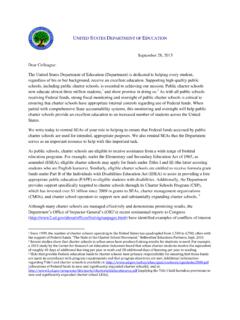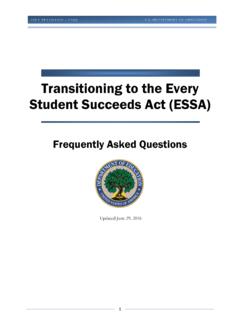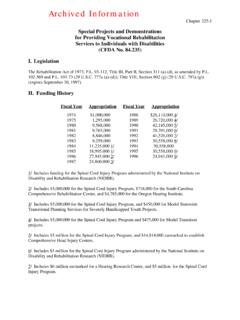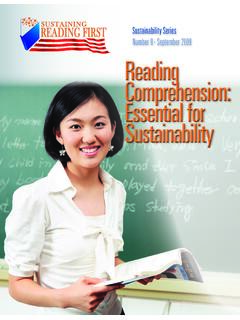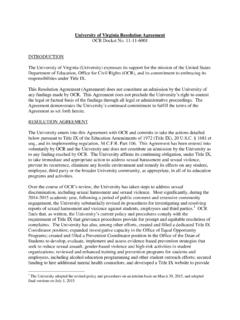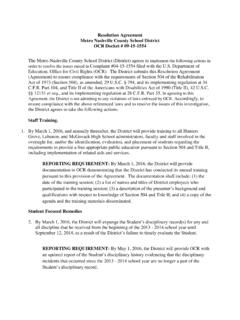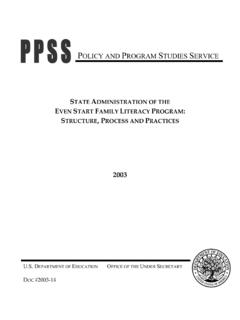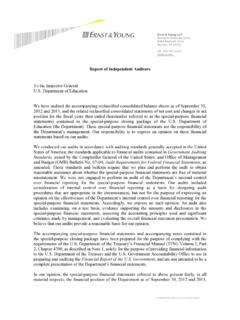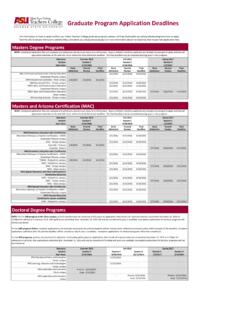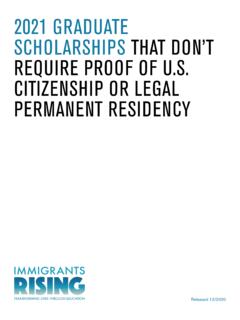Transcription of Supporting the Success of Homeless Children and Youths
1 July 27, 2016. Supporting the Success of Homeless Children and Youths A fact sheet & tips for teachers, principals, school leaders, counselors, and other school staff During the 2013-14 school year, more than million Homeless Children and Youths were enrolled in public schools. Since the 2006-07 school year, the number of Homeless Children and Youths enrolled in public schools has nearly doubled. The number of unaccompanied Homeless Youths (not in the physical custody of a parent or guardian) identified by schools has more than doubled to nearly 100,000 students. Youths of color and lesbian, gay, bisexual, transgender, queer and questioning (LGBTQ) Youths are disproportionately represented in this Research and data, including surveys of Homeless and formerly Homeless Youths , indicate that experiencing homelessness can have significant negative impacts on Children academically, socially, and emotionally.
2 Homeless students experience greater school mobility than their non- Homeless peers. School mobility can cause interruptions to a child's education and is associated with lower school achievement and increased risk of dropping out of school. ii Homeless students are at a greater risk of being chronically absent than their non- Homeless peers. iii Chronic absenteeism is associated with lower academic achievement and higher dropout rates. iv Homeless students face significant gaps in high school graduation rates compared to their peers, according to data from the States that disaggregate graduation rates for Homeless Two-thirds of formerly Over 40 percent of formerly Nearly 60 percent of formerly Homeless Youths surveyed said Homeless Youths surveyed said Homeless Youths surveyed said that homelessness had a significant that they dropped out of school or that their schools did a fair or impact on their education , stopped attending school while poor job of Supporting them making it hard to stay and do well they were Homeless in middle or while they were Homeless and in school.
3 Vi high school. vii that a lot more should be done. viii The education for Homeless Children and Youths (EHCY) program, authorized under the mckinney - vento Homeless Assistance Act ( mckinney - vento Act), is designed to address the needs of Homeless Children and Youths and ensure educational rights and protections for these Children and Youths . The Every Student Succeeds Act (ESSA) amended the mckinney - vento Act, and changes made by the ESSA will take effect on October 1, 2016. 1. July 27, 2016. Who is considered Homeless ? Under the mckinney - vento Act, the term Homeless Children and Youths means individuals who lack a fixed, regular, and adequate nighttime residence and includes Children and Youths : who are sharing the housing of others due to loss of housing, economic hardship, or a similar reason; are living in motels, hotels, trailer parks, or camping grounds due to the lack of alternative adequate accommodations; are living in emergency or transitional shelters; or are abandoned in hospitals.
4 Who have a primary nighttime residence that is a public or private place not designed for or ordinarily used as a regular sleeping accommodation for human beings;. who are living in cars, parks, public spaces, abandoned buildings, substandard housing, bus or train stations, or similar settings; and who are migratory Children who live in one of the above circumstances. ix What protections does the mckinney - vento Act require for Homeless Children and Youths ? Under the mckinney - vento Act, State educational agencies (SEAs) and local educational agencies (LEAs). must review and revise policies and procedures to remove barriers to a high-quality education for Homeless Children and Youths . Every SEA must have an Office of the State Coordinator to oversee implementation of the Act, and every LEA must designate a local liaison able to carry out their duties to ensure that Homeless students are identified and have a full and equal opportunity to succeed in school.
5 The mckinney - vento Act also requires that: o Homeless students who move have the right to remain in their schools of origin ( , the school the student attended when permanently housed or in which the student was last enrolled, which includes preschools) if that is in the student's best interest;. o if it is in the student's best interest to change schools, Homeless students must be immediately enrolled in a new school, even if they do not have the records normally required for enrollment;. o transportation must be provided to or from a student's school of origin, at the request of a parent, guardian, or, in the case of an unaccompanied youth, the local liaison;. o Homeless students must have access to all programs and services for which they are eligible, including special education services, preschool, school nutrition programs, language assistance for English learners, career and technical education , gifted and talented programs, magnet schools, charter schools, summer learning, online learning, and before- and after-school care.
6 O unaccompanied Youths must be accorded specific protections, including immediate enrollment in school without proof of guardianship; and o parents, guardians, and unaccompanied Youths have the right to dispute an eligibility, school selection, or enrollment decision. 2. July 27, 2016. Tips for Supporting Homeless Children and Youths All school staff have the opportunity and the charge to support Homeless students and families. While every LEA must have a mckinney - vento liaison, the number of Homeless students and the scope of their needs may be challenging for just one person to address. That is what makes the role of teachers (including early childhood educators), school leaders, counselors, and other staff so critical. Though Homeless Children and Youths may face great challenges, a caring adult who can ensure that a student's rights are upheld and can connect him or her to other supports can make a world of difference.
7 Below are tips for how to help Homeless students in your school or district. Create a welcoming climate and build trust with all students. Many Homeless students hesitate to identify themselves as Homeless due to shame, fear of stigma, and concern about possible consequences of this identification. By not being identified, however, these students miss out on critical supports. Building a safe and supportive environment in your school or classroom can benefit all students and alleviate these concerns for Homeless students. Help to identify and support Homeless students. While it is important to avoid jumping to conclusions about students due to their appearance or performance, there are often warning signs that a child or youth is experiencing homelessness. For example, a child may fall asleep repeatedly in class, wear the same clothes multiple days in a row, have poor hygiene, fail to complete homework, or be regularly late or absent.
8 Instead of punishing a student for these behaviors, it would be beneficial to get to the root cause and find out what supports you may be able to provide. Be sensitive and understanding. Many Homeless Youths experience trauma even before they become Homeless , and the experience of homelessness can expose Youths to violence, abuse, trafficking, and other traumatic experiences (including hunger and illness). Teachers and other school staff who deal directly with Children should always employ sensitivity and understanding in conversations with Homeless students. School leaders can help by ensuring that all staff members are trained in trauma-informed care. Ensure that school and classroom policies and procedures, such as disciplinary policies, are fair to Homeless students and do not negatively impact them because of their homelessness. Consider providing extra time or other accommodations for Homeless students on homework and projects, or extra resources that may be needed, such as access to printers, computers, and school supplies.
9 Review attendance policies to ensure that they do not disproportionately punish Homeless students, who may face difficulty arriving on time to school. Learn more about the mckinney - vento Act and connect with your local liaison. Read the Department of education 's (ED) updated EHCY program guidance, visit your SEA. website for a list of mckinney - vento liaisons and their contact information, and help Homeless students and parents know about their rights. x Connect Homeless students and families to services and housing assistance in your community, including through non-profit and faith-based organizations. For more information and resources on Homeless students, please call the National Center for Homeless education helpline toll-free at (800) 308-2145 or visit their website, the ED Homeless initiatives webpage, or the Department of Housing and Urban Development's education webpage.
10 3. July 27, 2016. i National Center for Homeless education (2015). Federal data summary: school years 2011-12 to 2013-14. Retrieved from ; National Center for Homeless education (2008). education for Homeless Children and youth program: Analysis of data from the 2006-07 federally required State data collection for the mckinney - vento education Assistance Improvements Act of 2001 and comparison of the 2004-05, 2005-06, and 2006-07 data collections. Retrieved from ; Department of Housing and Urban Development (2015). The 2015 annual Homeless assessment report to Congress: Part 1 point-in-time estimates of homelessness. Retrieved from ; Institute for Children , Poverty, and Homelessness (2012). Intergenerational disparities experienced by Homeless black families. Retrieved from ; and Cray, A., Miller, K., & Durso, (2013). Seeking shelter: The experiences and unmet needs of LGBT Homeless youth.
